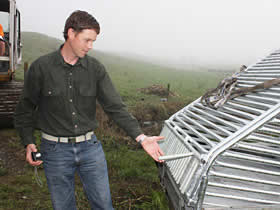
Dr Adam Daniel lifting one of the 'fingers' that will allow koi to leave Lake Ohinewai but not return.
A new barrier designed by a University of Waikato researcher may prove that removing pest fish from lakes and waterways can improve water quality, without forcing farmers to minimize profits.
Waikato University researcher Dr Adam Daniel says it's well known pest fish such as koi carp have played a key role in the a collapse of aquatic plants, loss of native biodiversity, algal blooms and reduced waterfowl production and that by removing them water quality may improve.
Nutrient run-off from farms has created an ideal habitat for pest fish to thrive within the Waikato region but University of Waikato researchers are hopeful removing pest fish can help restore some lakes without forcing farmers to drastically reduce their fertilizer use.
Dr Daniel has designed and installed a barrier on an outlet stream coming from Lake Ohinewai â€" near Huntly. "We know from previous research conducted by the University of Waikato that fish frequently move out of lakes and then return so we are taking advantage of that behavior by installing a one-way barrier."
By removing the remaining koi carp population and measuring the resulting water quality, scientists hope to prove pest fish are a major cause of damage to Waikato lakes and the river and provide a template for cleaning the lakes up.
While researchers are hopeful that pest fish removal alone will improve water quality it is likely a combination of nutrient reduction and fish removal will be necessary to restore the Waikato's shallow lakes.
The barrier is designed to allow koi carp to move on to Lake Waikare and the Waikato River but not return and is similar to a koi carp trap, designed by Leigh Thwaites of the SARDI laboratory (Australia), that will be installed next year at Lake Waikare by the Waikato Regional Council.
"It's a real simple system really," says Dr Daniel. These metal 'fingers' hang in the water and are weighted so the koi can push through, but they only open one way so once the carp have pushed through they're locked out of the lake," said Dr Daniel who's part of LERNZ, the Lakes Ecosystem Renewal New Zealand program based at Waikato University and funded by the Foundation for Research Science and Technology.
Waikato University biologists are at the heart of a $10 million project over 10 years to research and save New Zealand's lakes. The program focuses on the Rotorua Lakes but will have a nationwide application.
A study by Dr Daniel in 2008 showed carp travel between lakes and the river using storm drains and streams and can travel as far north as 800m from the sea at Port Waikato and as far south as Otorohanga. There is a real danger pest fish will continue to spread.
Lake Ohinewai is the perfect place to test the barrier as it has about 12 inlets and only one outlet, which allows carp to use the stream to seek out other water bodies, while stopping them from returning.
Koi carp damage lakes by eating the insects and plant material found in the lake bed that native fish and waterfowl usually would. In the process of doing this they stir up sediment in the water causing algae blooms and dirtying the water so plants can't grow.
Earlier this year University of Waikato scientists removed about 60% of the koi from Lake Ohinewai. To date more than two tonnes of carp have been removed from the lake, with more than 300kg of fish caught in one catch. The Lake Ohinewai restoration project was partly funded by the Department of Conservation which played a key role in the planning and implementation of the fish removal.
